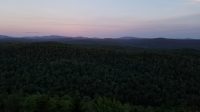Katie Conti – Independent Learning
by kaconti
- May 9
- in
Independent Learning Post
By Katie Conti
VR Storytelling Spring 2018
Audio editing was one of the most challenging aspects of my final project, a 360° video experience of Own The Dome. Although I once messed around in Garage Band during a two-week DJ phase in high school, I largely have next to no experience editing sound for videos I have produced. All projects in the past were soundtracked by one single audio file or by voiceovers that had been recorded in a quiet room/recording studio.
Going into the project, I knew that capturing audio using the Insta360Pro in the Carrier Dome would be a bit difficult. There are really poor acoustics in there - it's like speaking (or singing) into a giant void, and sound gets lost easily. I tried to counteract this by using an external microphone for some of my shots, but unfortunately the batteries died shortly into the evening. Many of my voice overs had to be re-recorded using my iPhone later in the editing process.
I started off the audio editing portion of my project by watching some of the Premiere Pro Guru: Mixing Audio Clips and Tracks course on Lynda.com. Having spent some time recording my own music in a studio and recording an album with my a cappella group, some of the audio editing lingo seemed familiar. It was helpful to have someone lay out for me what each of the audio tools could do, and I ended up mostly learning by doing. For normalization, I struggled to understand the difference of volume versus gain, but this article helped me to better understand. I attempted to aurally hear when I thought the mix sounded better on these parts especially. I started by selecting a number of cuts where the volume was of pretty equal loudness, hit "Normalize all Peaks" and turned down the decibel level limit. I took the method of cutting the video / audio before and after the incredibly loud points where excited cheering and shouting produced scratchiness due to incoming volume levels that were way too loud. I learned that lowering these levels would help with the mix, because it didn't affect the normalization I had just done on the clip before and after the loudest ones. I also learned how to add a Limiter to a certain clip that has a very short time where the audio goes super loud. I looked at the waveforms of the audio clip set a height limit to the volume of the entire clip that only effected the one portion where the loudness was uncomfortable to listen.
I also learned how to use the pen tool to put in key frames and manually create a fade in/fade out of the audio tracks. This was particularly helpful when putting in the background music I downloaded from freesound. It was neat to adjust the music's start/stop time or fade in/fade out volume level to add additional feeling to the video clip atmosphere and drama to my storytelling. The area where I tried to focus in on this was in the Ultimate Rock Paper Scissors Challenge sequence. I clicked the line on the overall audio volume bar in the editing panel, and made several points that I could move up or down to have a fade in or fade out or just lower the track for other audio to overlay on top. To continue editing the key frames later, I learned how to manipulate them in the effects control panel. The key frames there matched up with the key frames in the timeline but I was also able to see the tract level in this view and adjust that too.
Using the EQ effect, I was able to bring out more of the base in one of my backing tracks. These were all electronic sounds, not orchestral/instrumental, so I chose to focus on bringing up the base volume frequency up to add a little heartiness to the backing track. These tracks were meant to be goofy, fun, and atmospheric and in the end, I thought the EQ effect was particularly helpful in making this happen.
In addition, I read a few articles about voice inflection and tone, and gave my narrators mini coaching sessions before we recorded the voice overs. Almost all of them were recorded in the same room with the same set up, but I still had to edit the voice volume levels in premiere, as one of the narrators spoke too loudly and one spoke a little too quietly at parts.
I definitely have a long way to go in learning how to mix audio. In the future, I'll try to do more pre-shoot planning on audio tracks, voice overs, etc. and try to ensure that the audio can be captured well enough by the camera in an area as open as the carrier dome, or ensure that I bring a working external microphone with me. I hope that I can learn how to edit background noise even better and incorporate more of the adobe effects into my audio mixing.

COMMENTS